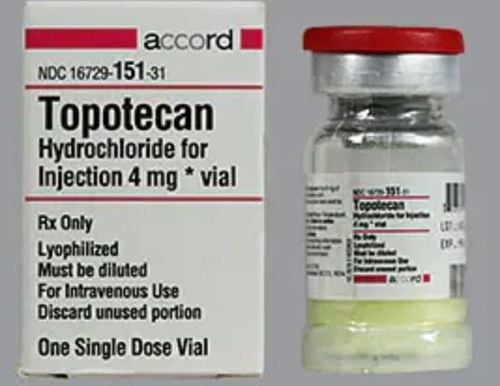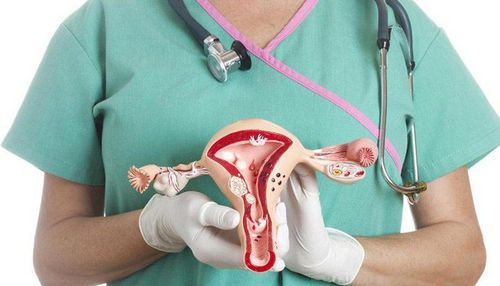This is an automatically translated article.
The article was professionally consulted by BSCK II Phung Thi Phuong Chi - Oncologist - Oncology Center - Vinmec Central Park International General Hospital. The doctor has 20 years of experience in the field of oncology.Ovarian cancer is one of the most common cancers in the female reproductive tract. The disease can occur at any age, but the target audience is mainly post-menopausal women, with an average age of about 60 years.
1. What is ovarian cancer?
Ovarian cancer is a type of cancer that affects one or both of a woman's ovaries. In general, the percentage of patients with ovarian cancer is not much. However, because ovarian cancer is often not detected until it is in an advanced stage, it is considered the leading cause of gynecological cancer death in the United States.2. Ovarian cancer classification
Ovarian cancer cells can grow on the epithelial lining of the ovary or from tissues within the organ. Pathologically, there are three main types of ovarian cancer. However, the most common are cancers that originate in the epithelium of the ovary, or ovarian carcinoma. Approximately 90% of ovarian cancers involve tumors in the epithelial layer. The information in this article mainly deals with ovarian carcinoma.3. Risk factors for ovarian cancer
Many risk factors are associated with ovarian carcinoma. The factors listed below have been shown to increase the risk of cancer in women:Over age 55 Family history of breast cancer, ovarian cancer, colon cancer or endometrial cancer (or endometrial cancer) Personal history of breast cancer Have BRCA1 and BRCA2 mutations Never been pregnant Infertile Have endometriosis Have Lynch syndrome (is a genetic condition that increases the risk of colon cancer and some other cancers).
4. Ovarian Cancer Screening Test
Screening tests are tests done when there are no symptoms. For example, do a colonoscopy to detect colorectal cancer, or a Pap test to screen for cervical cancer.Until now, there is no test to help screen for ovarian cancer. Therefore, you should be alert to any changes in your body and talk to your gynecologist or oncologist as soon as you notice signs of ovarian cancer. The earlier ovarian cancer is detected, the better the chances of successful treatment.
5. What are the signs of ovarian cancer?
If you notice any of the following symptoms, especially when they occur for more than 12 days per month, it is most likely a sign of ovarian cancer:Bloating, bloating or increased Abnormal waist size Pelvic or abdominal pain Feeling of loss of appetite, indigestion, or unexplained satiety Urinary system-related symptoms (occurring, acute) In addition, symptoms Ovarian cancer can also be: vaginal bleeding (especially after menopause), abnormalities in the gastrointestinal tract, such as bowel movements, difficulty in defecation due to a large tumor pressing on the wall of the rectum. However, detecting these signs does not mean that you have ovarian cancer, but it is advisable to find out and talk to your doctor to determine the exact cause.

Dấu hiệu của ung thư buồng trứng dễ nhầm lẫn với các bệnh khác
6. Ovarian cancer diagnosis
If you find yourself experiencing symptoms of ovarian cancer, you should proactively see your gynecologist. To diagnose ovarian cancer, your doctor may order an imaging test to look for ovarian cancer, such as a transvaginal gynecological ultrasound.You may also have a blood test to measure your CA 125 level. CA 125 is a protein that is considered a marker of cancer.
80% of women with ovarian cancer have elevated CA 125 levels. Therefore, the results of these tests are used to evaluate the likelihood of ovarian cancer in patients with ovarian tumors.
7. Ovarian cancer treatment
Surgery is one of the main methods of treating ovarian cancer. Surgery to remove the uterus, ovaries, fallopian tubes, and large omentum to stop the growth and spread of cancer cells. Lymph nodes and tissues in the pelvis and abdomen will all be examined and removed if necessary. In some cases, at a very early stage and the patient has a need to preserve reproductive function, doctors only remove one side of the cancerous ovary.In addition, adjuvant chemotherapy after surgery is the recommended method for most cases of ovarian cancer. Chemotherapy is a method of using different drugs to kill cancer cells, but there is a risk of affecting healthy cells and leaving many serious side effects. In some cases, doctors may assign patients to undergo chemotherapy before surgery when the disease is too late to have surgery in the first place. In addition, many studies show that treatment with vascular antibiotics along with chemotherapy can help reduce recurrence and improve survival in advanced and metastatic stages of ovarian cancer.
8. Follow-up after ovarian cancer treatment
After treatment, patients need to be periodically re-examined to detect and treat early ovarian cancer recurrence and metastasis. Follow-up after cancer treatment is usually an assessment of symptoms and a physical exam. Tests may include testing for levels of CA 125. Imaging tests are not usually performed, but may be recommended if necessary, depending on suspicious findings. examination includes ultrasound, chest X-ray, magnetic resonance imaging (MRI), or computed tomography (CT scan).9. How to reduce the risk of ovarian cancer?
Using combined hormonal birth control pills (those that contain both the hormones estrogen and progestin) may reduce the risk of ovarian cancer. The longer you take the medicine, the less likely you are to get sick. On average, every 5 years of taking the pill, women reduce their risk by about 20%. However, this benefit needs to be weighed against the risks associated with using the drug. Combined hormonal birth control pills are safe for most women, but increase the risk of deep vein thrombosis, angina, and stroke.Many current theories suggest that some types of ovarian cancer may originate in the fallopian tubes. If you need a hysterectomy or have had sterilization to prevent pregnancy permanently, you can talk to your doctor about having your fallopian tubes removed. For this surgery, only the fallopian tubes are removed, not affecting the ovaries. Surgery to remove the fallopian tubes minimizes the risk of ovarian cancer in the future.
Gynecological cancer screening and early detection package at Vinmec
When registering for Vinmec's Gynecological Cancer Screening and Early Detection Package, customers will receive:Visit and receive direct consultation with a specialist in Obstetrics and Gynecology. Screening for gynecological cancers by modern tests, such as cytology by Liqui Prep method, automated system HPV genotype PCR test, transvaginal ultrasound test of uterus and ovaries . This package helps prevent ovarian cancer even when there are no symptoms.

Bệnh viện đa khoa Quốc tế Vinmec là địa chỉ hoàn hảo giúp bạn phát hiện và điều trị bệnh ung thư buồng trứng, từ đó bảo vệ tốt nhất cho cuộc sống của mình.
Please dial HOTLINE for more information or register for an appointment HERE. Download MyVinmec app to make appointments faster and to manage your bookings easily.
Reference source: Acog.org.











